Korean Rose Jjimdak: Creamy Gochujang Braised Chicken
This post may contain affiliate links, please read our disclosure policy for details.
This is Rose Jjimdak recipe, a Korean braised chicken made with creamy gochujang sauce. This is one of the trendiest and most loved Korean chicken dishes in Korea right now.
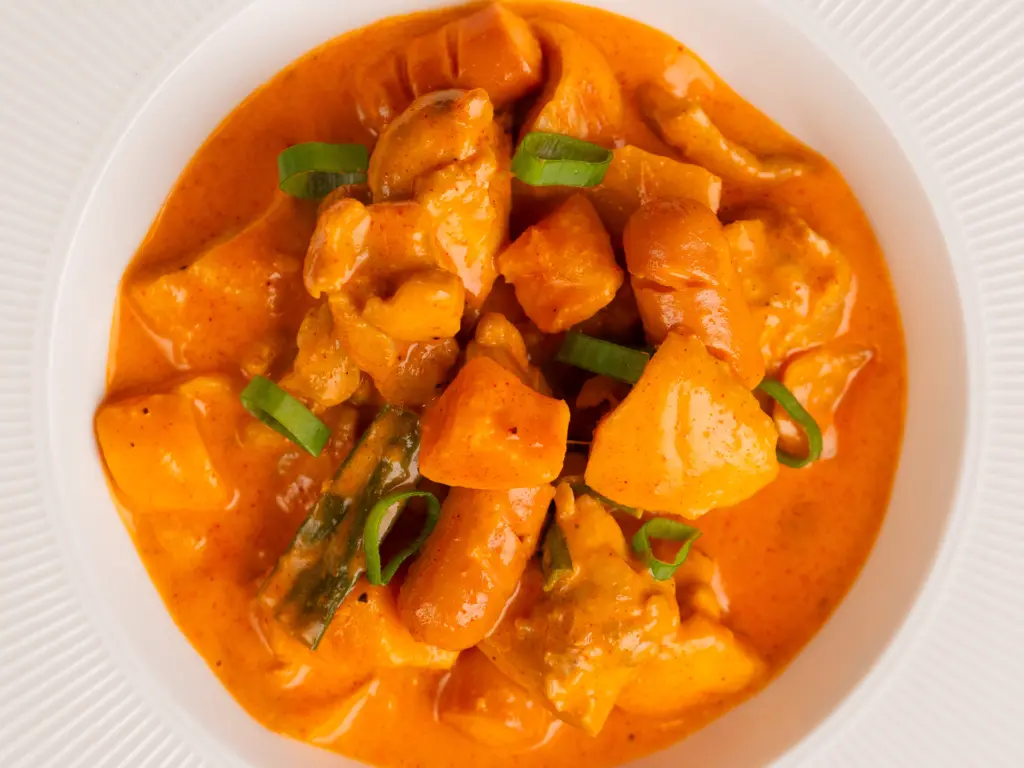
What is Rose Jjimdak? 로제 찜닭
Actually, Rose Jjimdak is not a traditional Korean dish. You might have heard of Andong jjimdak, a dark, soy sauce based braised chicken dish. It’s considered the traditional version of Korean jjimdak.
Jjimdak is a Korean dish in which chicken is braised in a sweet and savory soy sauce base. It usually includes vegetables such as potatoes, carrots, and green onions, as well as a small amount of glass noodles (dangmyeon). Jjimdak is not meant to be a single-serving dish. It’s typically enjoyed by two to four people gathered around a table and is always eaten with a bowl of rice. The noodles are just a small part of the dish because the focus is on enjoying the jjimdak as a main dish with rice.
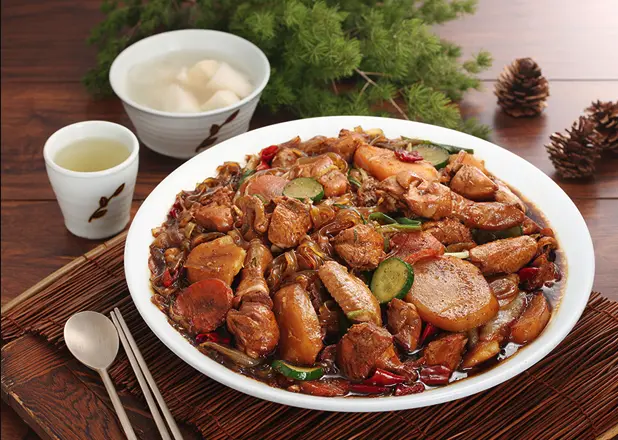
Have you heard of rose tteokbokki? Today’s recipe is a twist on jjimdak made with rose tteokbokki sauce. This Korean-style sauce, made with gochujang and cream, is creamy, slightly spicy, and sweet. It goes perfectly with chicken. This dish has become especially popular in Korea thanks to the jjimdak restaurant chain Doojjim(두찜), where it’s one of their most famous and best-selling menu items. If you ever visit Korea, I highly recommend trying it!
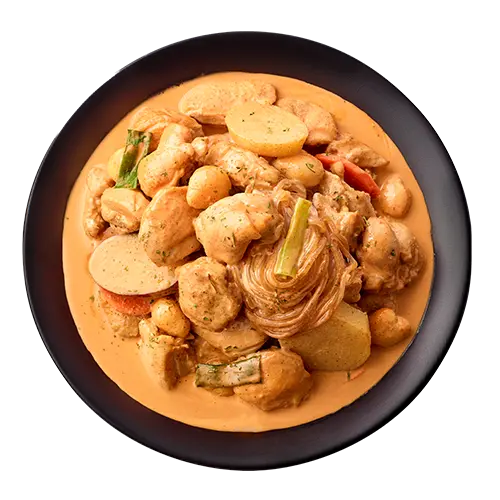
Gochujang Cream Sauce (Rose Tteokbokki Sauce)
You may know the sauce as creamy gochujang sauce, which Koreans have enjoyed for quite some time, especially in the popular dish, tteokbokki. It is made by mixing gochujang (Korean chili paste) with cream and sugar for sweetness. A dash of MSG or Dashida (a Korean soup stock powder) is added to enhance the umami flavor. That MSG or Dashida? It’s absolutely essential. Without it, your homemade rose tteokbokki might not taste quite like it does at the restaurant.
Here’s a secret ingredient that many Korean tteokbokki restaurants use: a small amount of curry powder. It may sound unexpected, but just a tiny pinch gives the sauce that restaurant-level flavor you’ve probably experienced before. So, if you’re trying to make rose tteokbokki sauce at home—or use it in dishes like rose jjimdak—don’t skip the MSG, dashi-da, or curry powder! These little touches make all the difference!
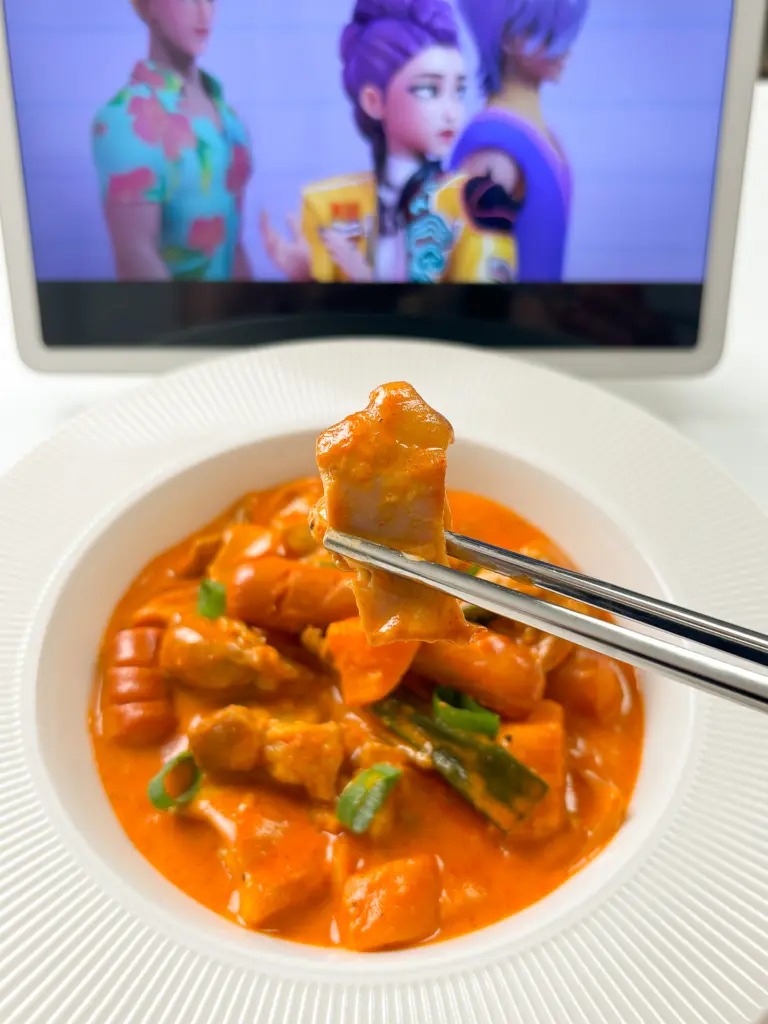
Rose Jjimdak Ingredients
Here’s what you’ll need to make jjimdak with rose sauce, along with some optional add-ons to customize it your way.
Chicken
- Boneless chicken thighs are highly recommended. They’re juicy, tender, and perfect for soaking up the creamy gochujang sauce.
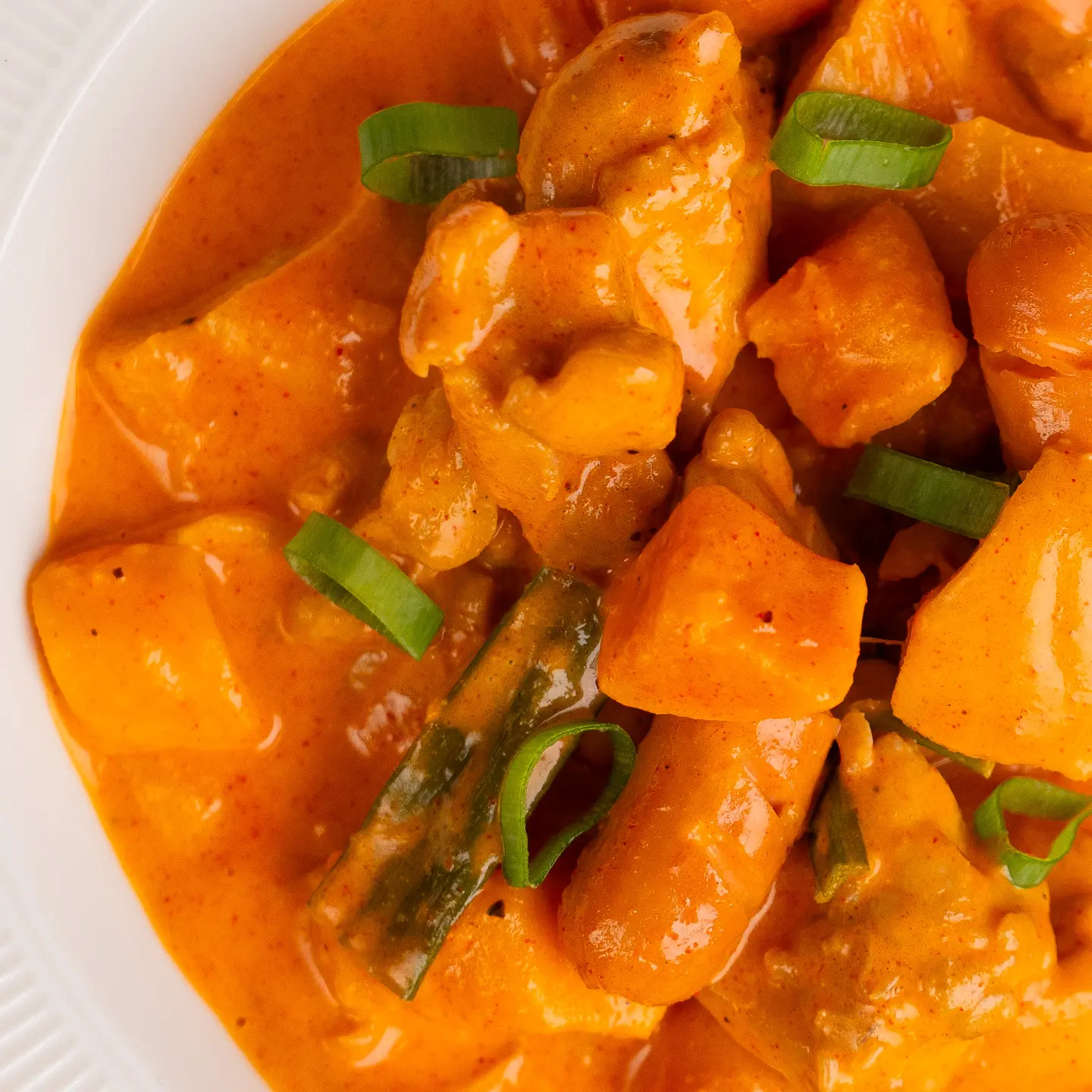
Rose Sauce
This is the heart of the dish—a savory, creamy, spicy blend that makes rose jjimdak so addictive.
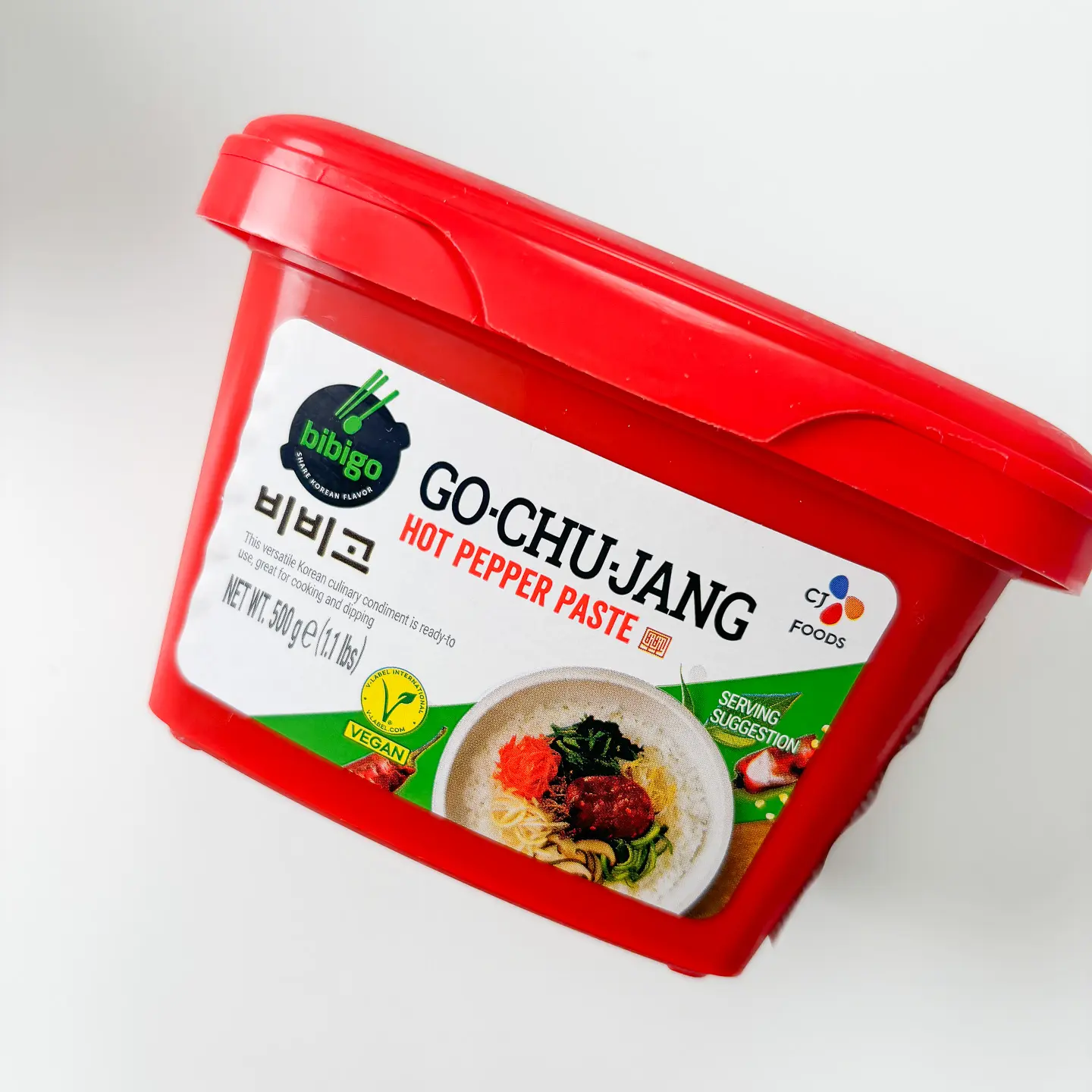
- Gochugaru (Korean chili flakes) – adds bright heat and color
- Minced garlic – for that bold Korean flavor
- Sugar – balances out the heat
- Beef Dashida – Korean soup stock powder for deep umami
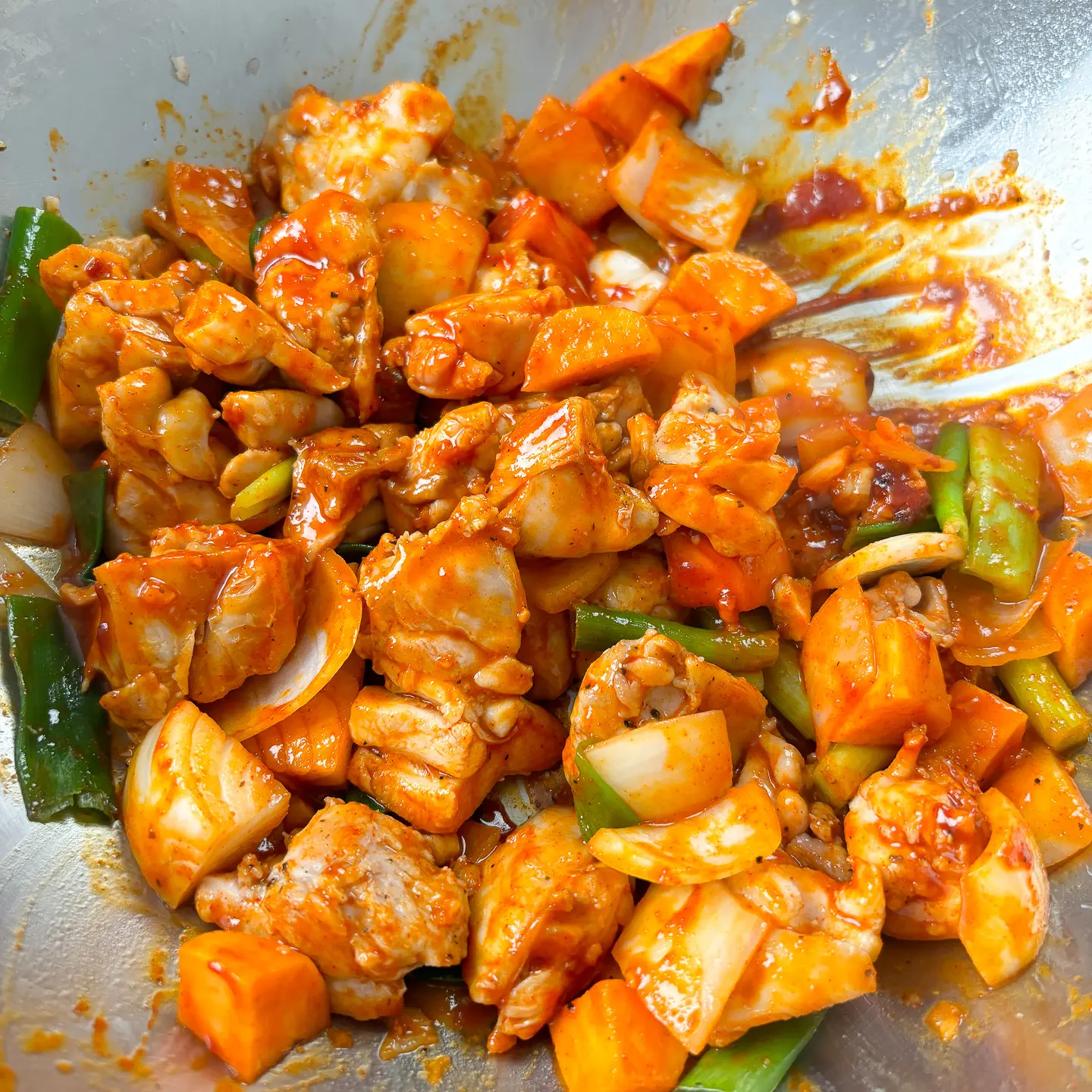
- Oyster sauce – adds savory depth and richness
- Curry powder – just a small amount gives the sauce that special restaurant-style flavor
- Salt & black pepper: for basic seasoning of the chicken before cooking
Vegetables & Add-ins
- Sweet potato, green onion, onion, sausage
Optional Add-ins (Highly Recommended!)
- Carrot, potato, tteok (Korean rice cake), wide glass noodles
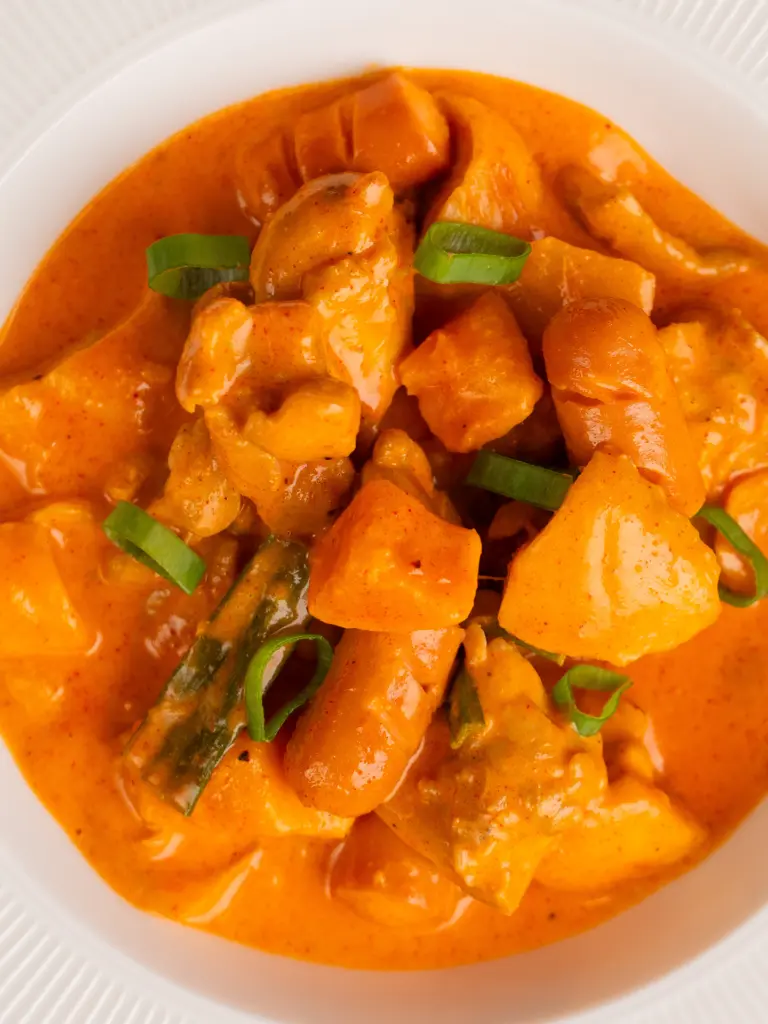
Rose Jjimdak Recipe Tips
To make sure your Rose chicken turns out perfectly, here are two important tips to avoid common mistakes.
- Don’t Cut Sweet Potatoes Too Big
If the sweet potato chunks are too large, they’ll take much longer to cook—and you might end up with pieces that are still undercooked inside. In classic dakjjim, big chunks are fine because the dish simmers for a long time. But today’s recipe is more like a stir-fry-braise style, which cooks faster. So make sure to cut your sweet potatoes (or regular potatoes) into smaller pieces for even cooking.
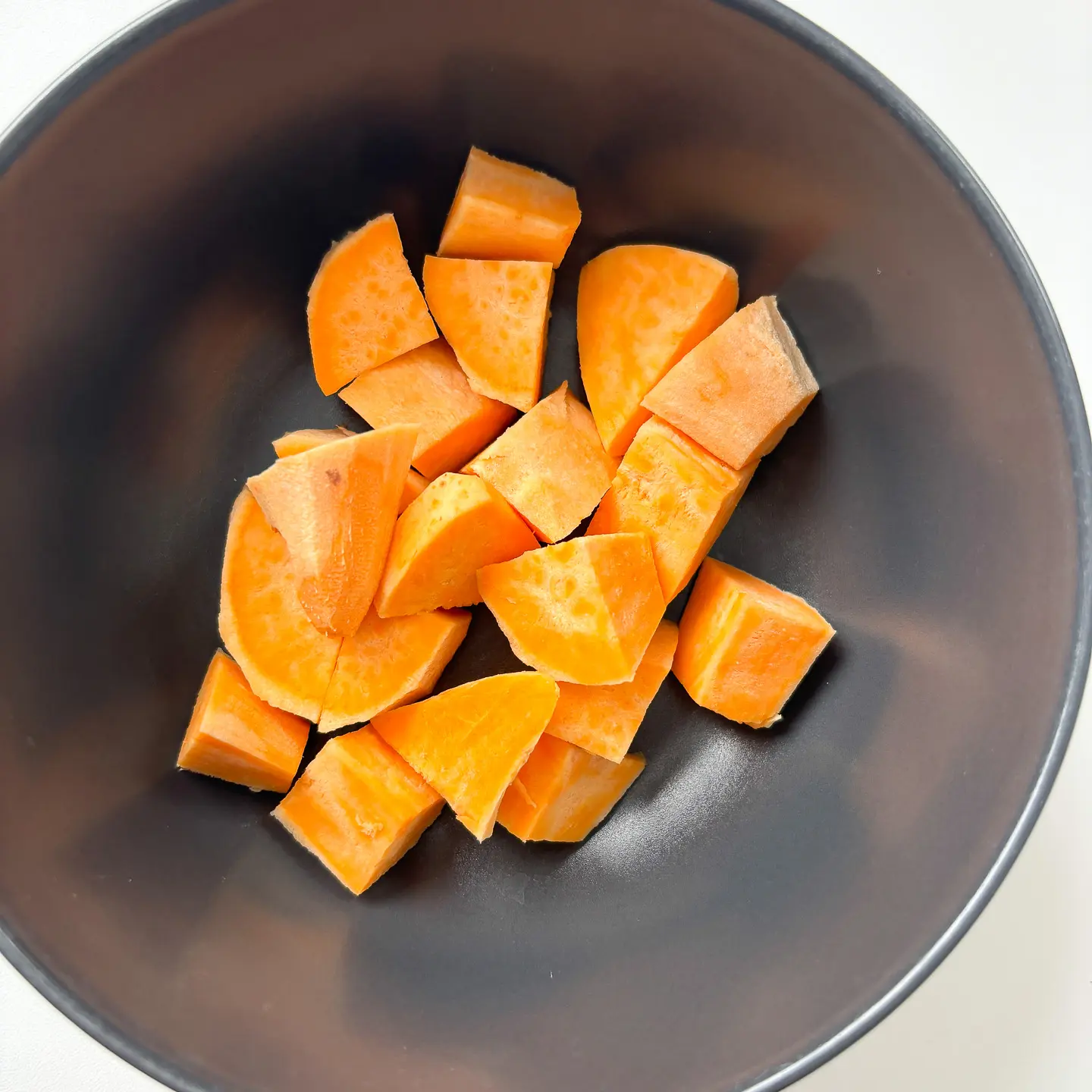
- Don’t Use High Heat After Adding Cream
Cream evaporates quickly, especially over high heat. If you boil the sauce after adding the cream, the liquid will evaporate quickly and you’ll end up with a dry pan. Instead, simmer gently over low heat to allow the flavors to meld while maintaining a creamy texture. If the sauce reduces too much, don’t worry—just add a splash of milk to loosen it up again. Adding more cream may make the sauce too heavy, so milk is a better option for adjusting the consistency.

Too Spicy? Here’s How to Make Milder
Rose Jjimdak isn’t considered a spicy dish for most Koreans, but if you’re sensitive to heat, it might still feel a bit too much. Here’s how to adjust the spice level without losing flavor.
- Use less gochujang. You can slightly reduce the amount of gochujang and replace it with a bit of tomato sauce. It still gives great depth and color without the heat.
- Add cheese on top. A final touch of shredded cheese melts beautifully into the sauce and helps balance the spice, making the dish creamy and mellow.
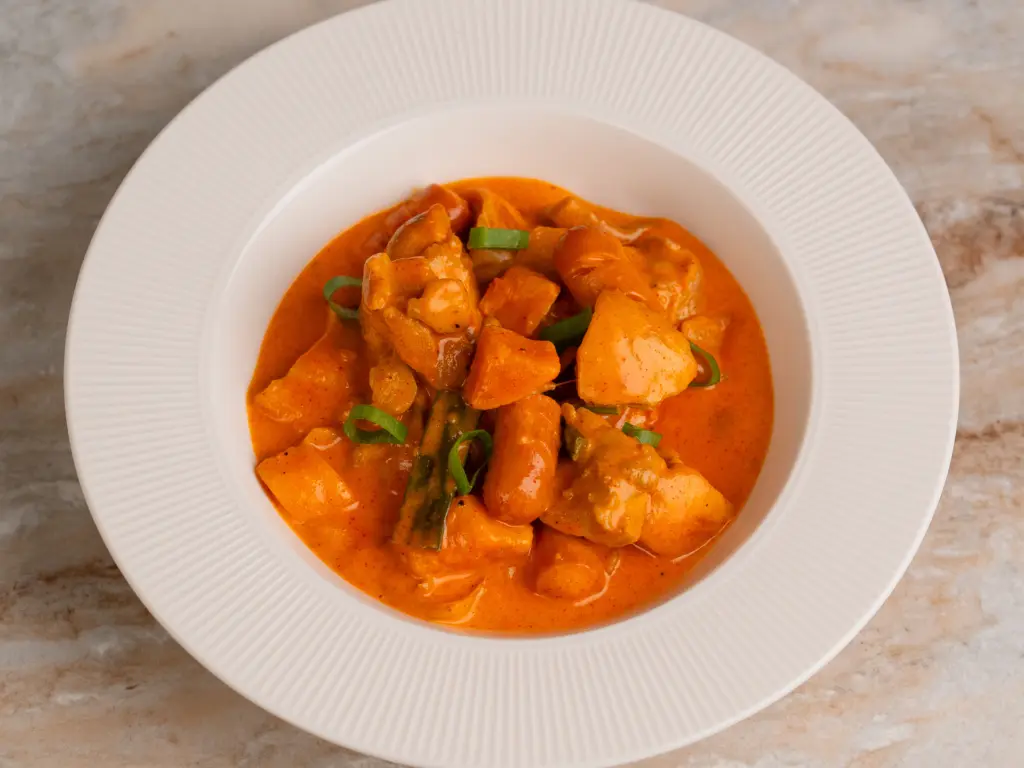
What’s the Best Cut of Chicken?
Although you can use bone-in chicken for traditional Korean braised chicken, there’s a preferred cut for Rose dakjjim: boneless chicken thighs. Many Koreans don’t like dry chicken breast. They prefer juicy and tender chicken thighs. That’s why, when eating Korean fried chicken, if you take both drumsticks for yourself, there’s a 99% chance it’ll start a fight. I’m serious. Haha!
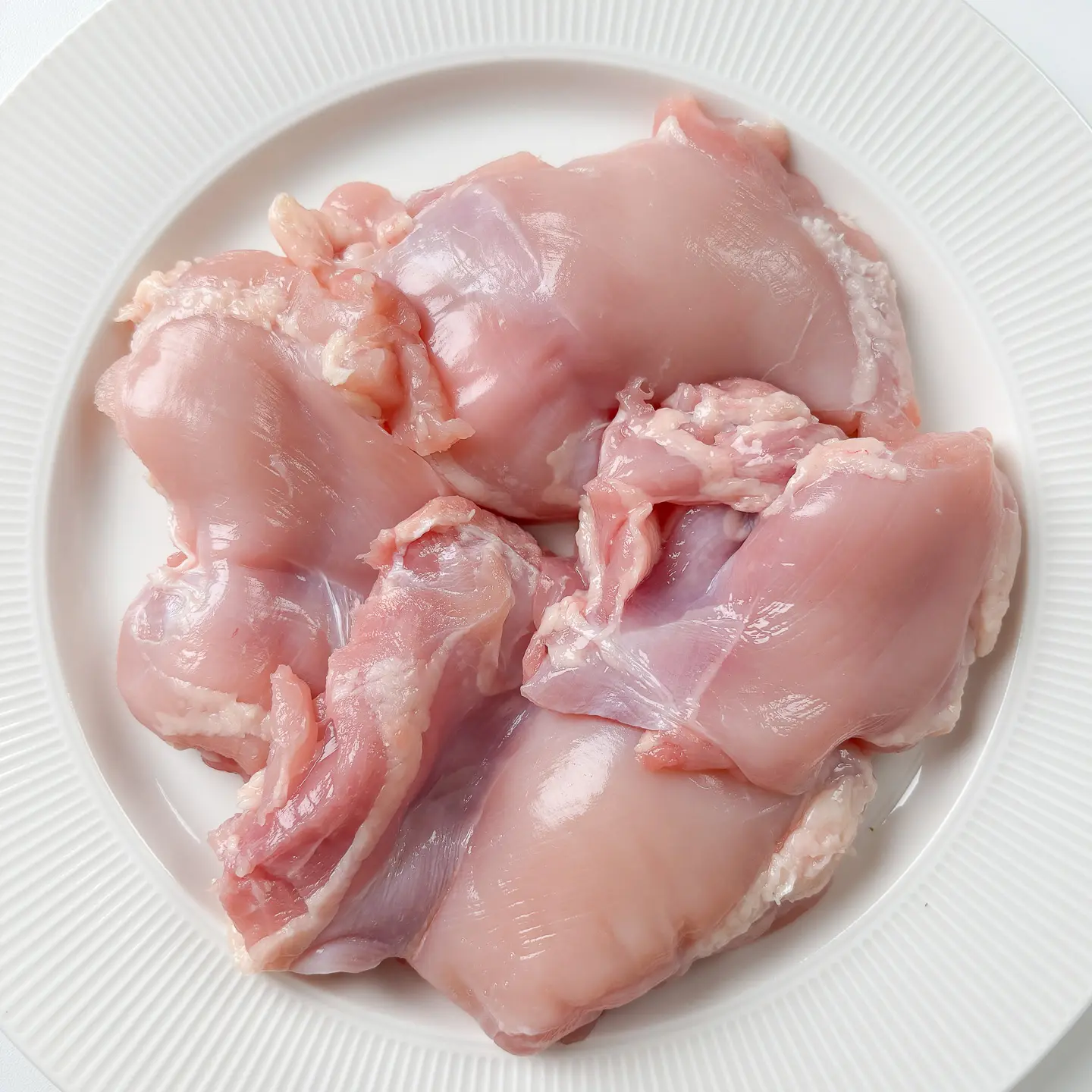
Topping Ideas for Rose Braised chicken
If you’ve ever been to a Korean restaurant, you’ve probably noticed how we love adding extra toppings to dishes like tteokbokki. Today, I’m sharing some of my favorite toppings that go perfectly with Rose chicken!
- Cheese: Melted mozzarella cheese on top of rose chicken makes it creamier, richer, and just more delicious overall. If you don’t like greasy or heavy food, you can skip it—but honestly, I highly, highly recommend it. Especially if you can’t handle spicy food, you’ll love this combination. It makes everything smoother and easier to eat.
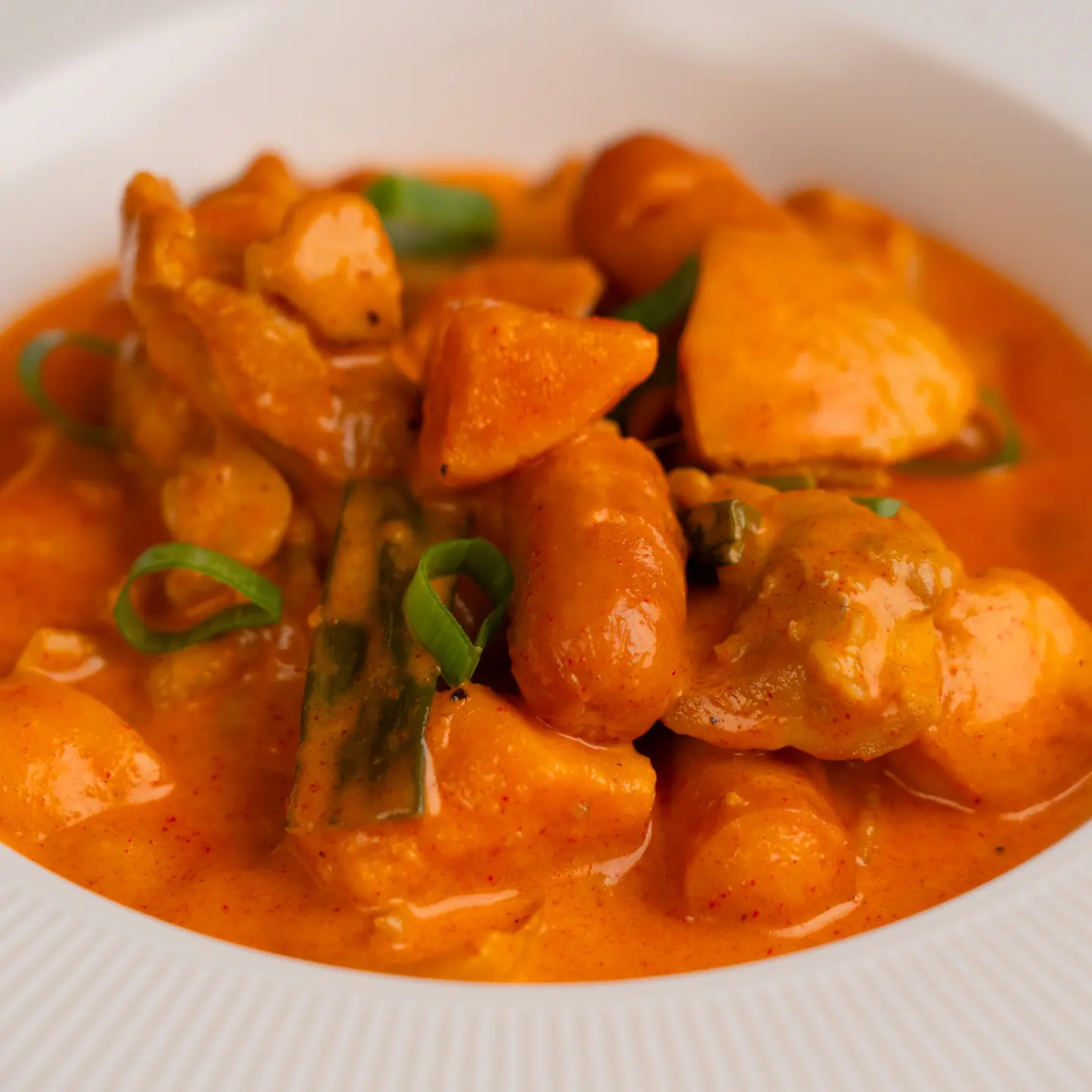
- Gim-mari (Seaweed Glass Noodle Rolls): If you’ve ever had tteokbokki at a Korean snack shop, you’ve probably seen gim-mari—glass noodles wrapped in seaweed, battered, and deep-fried. Since Rose chicken uses a similar rose tteokbokki sauce, gim-mari makes an amazing topping. Don’t forget to dip it in that creamy gochujang sauce!
- Fried Mandu: Just like with tteokbokki, fried mandu taste amazing dipped in the creamy gochujang sauce. My go-to brand is Bibigo Mandu—they’re crispy, flavorful, and super easy to prepare. I’m especially happy that I can find them even here in Belgium, where I live now!
- Shop bibigo Mandu: US
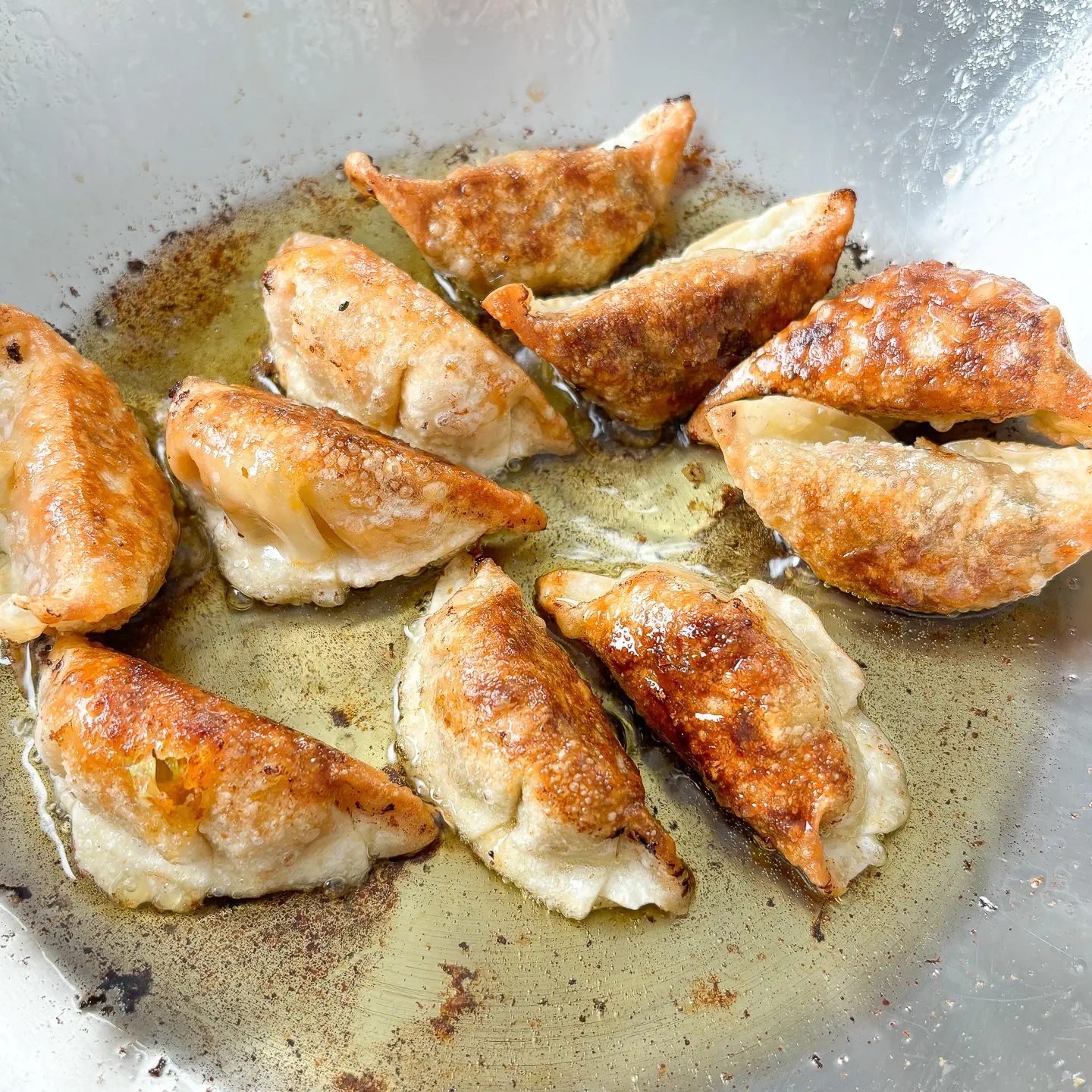
Got Leftovers?
If you’re cooking rose Korean chicken for one, chances are you’ll have leftovers. But don’t worry! Here’s a fun and delicious way to enjoy rose braised chicken the next day: Make what I call a “K-dessert” fried rice! Shred the leftover chicken into small pieces and stir-fry them with rice, leftover vegetables, and some of the remaining sauce. Finish it off with a generous handful of mozzarella cheese and let it melt. The result is a completely new dish—and honestly, some people even prefer this fried rice version over the original. It’s comforting, cheesy, and packed with flavor. Give it a try before throwing anything out!
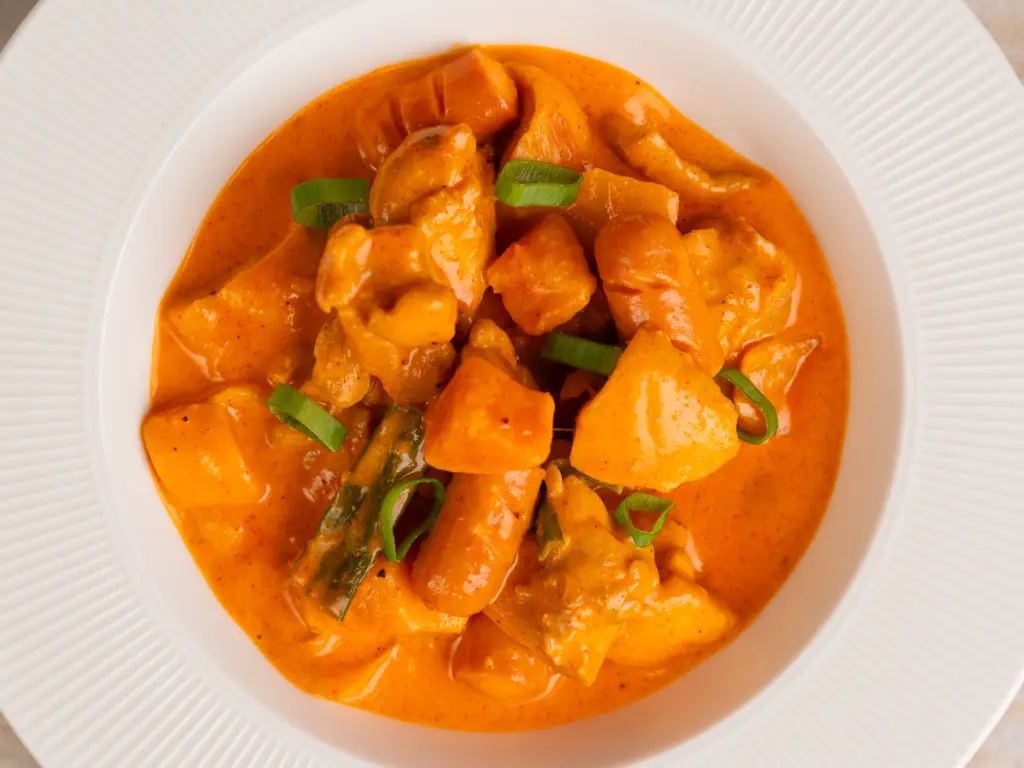
Korean Rose Food
In Korea, rose sauce—a mix of gochujang and cream—has been popular for quite some time. And Koreans love to get creative with it, making all kinds of delicious dishes. While today’s Rose Jjimdak is a super trendy example, here are a few more Korean food that use this rich and creamy gochujang sauce.
Rose Tteokbokki
This is probably the dish that introduced you to Korean rose sauce. The creamy gochujang gives it a sweet, mildly spicy, and rich flavor that’s hard to resist. It’s one of the most iconic rose dishes in Korea.
Best Rose Tteokbokki in 15 Minutes – One Pan Recipe
Rose Pasta
Koreans even use rose tteokbokki sauce to make pasta. Some versions have a strong gochujang flavor, just like the creamy chili paste base used in rose tteokbokki. Others use less gochujang and add more tomato sauce, creating a lighter rose pasta with just a hint of that Korean kick. Which style do you prefer?
Rose Mandu Gratin
You’ve probably had mandu, or Korean dumplings, before. Have you tried baking them like a gratin? Koreans often put mandu in an oven-safe dish, pour tomato sauce over them, add lots of cheese, and microwave or bake them until they’re bubbling. I made with rose sauce instead of tomato sauce, and it was amazing! The creamy gochujang flavor pairs perfectly with the crispy dumplings. Highly recommend!
Mandu Gratin with Rose Sauce: 5-Minute Bibigo Dumplings
Korean Chicken Recipes
There are many different chicken dishes in Korea. Let me introduce you to some delicious Korean chicken recipes.
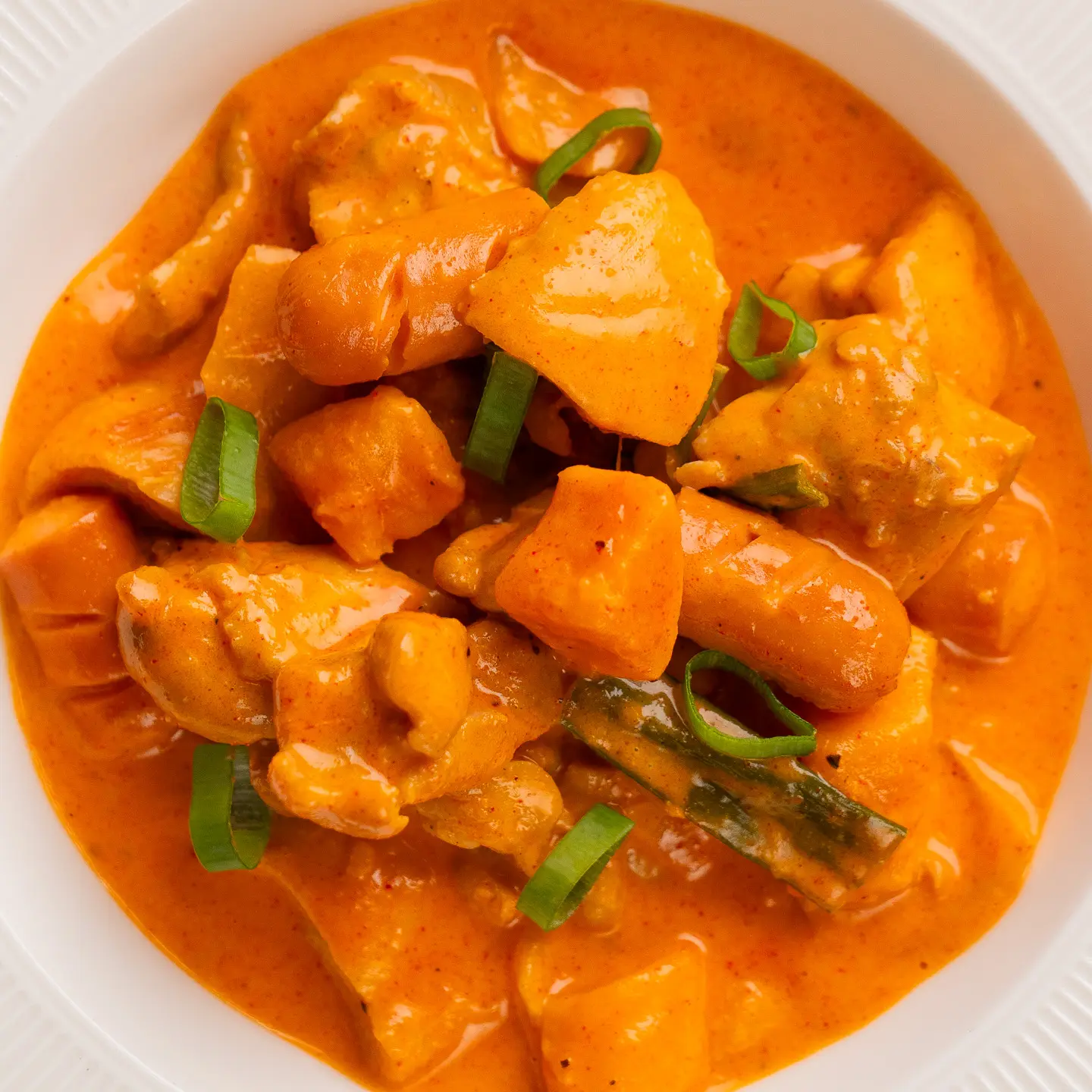
Korean Fried Chicken
This is the Korean fried chicken you all know. In Korea, the most popular menu is “ban ban chicken,” which means half with yangnyeom sauce and half plain fried. The yangnyeom sauce in this recipe is exactly the flavor you would taste in Korea. Every time I eat Korean yangnyeom chicken in Europe, I often feel like it tastes too much like gochujang—and think, “This isn’t the real Korean flavor.” That’s why I really want you to try this authentic Korean yangnyeom chicken sauce.
Ban Ban Korean Fried Chicken – Half Yangnyeom & Half Fried
North Korean Chicken
This is a braised chicken dish from North Korea. It doesn’t use a lot of ingredients, but the unique method of boiling and steaming makes the chicken extra tender and juicy, and the broth is really rich. The sauce you dip the chicken into is made with chili powder and chicken broth, and you can customize it to your taste—that’s part of the fun.
North Korean Food: Braised Chicken (Easier Than Samgyetang)
Cheese Dakgalbi
You might already be familiar with dakgalbi. About 20 years ago, most dakgalbi didn’t come with cheese. Now, however, almost every restaurant that serves it adds a cheese topping. Dipping spicy, sweet dakgalbi into a pool of melted mozzarella cheese is surprisingly delicious. This recipe recreates the flavor of a famous dakgalbi restaurant near Gangnam Station.
Cheese Dakgalbi (Korean Spicy Chicken Stir Fry) – Famous Seoul Restaurant Style
Kitchen Guide for Chicken with Rose Sauce
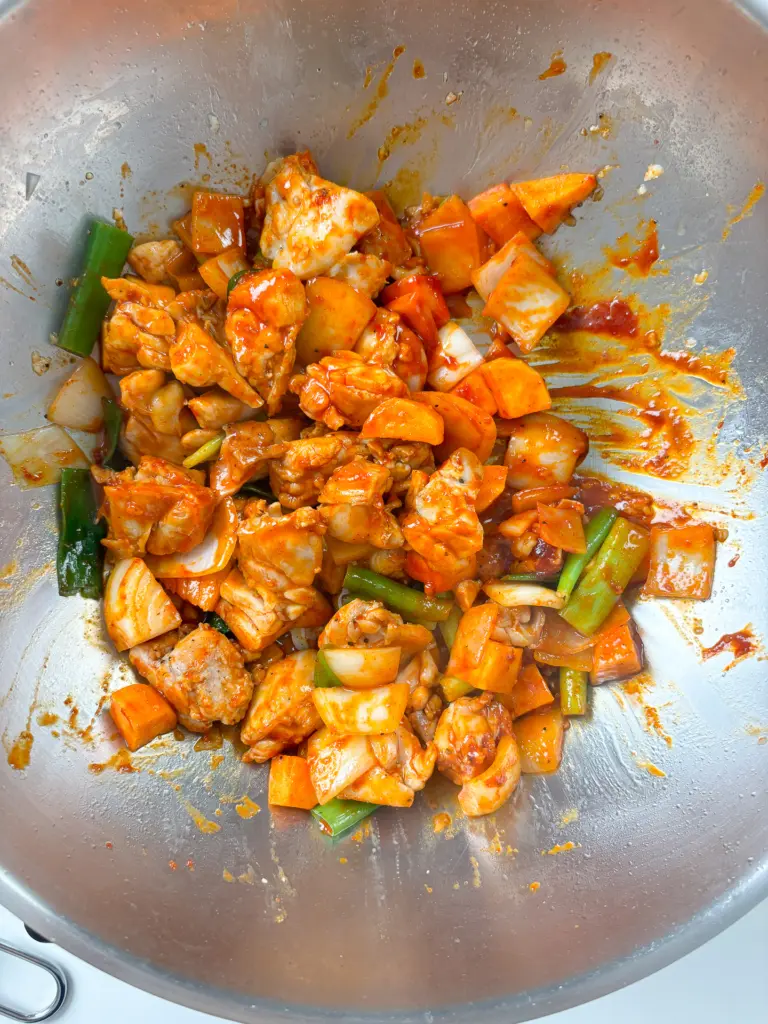
- Beef Dashida (umami kick): US l UK
- Oyster Sauce: US l UK
- Curry powder: US l UK
- Frank Sausage: US l UK
Disclosure: Blonde Kimchi is part of the Amazon Services LLC Associates Program, an affiliate advertising program that allows websites to earn advertising fees by linking to Amazon.com and promoting products.
FAQs about Rose Jjimdak
What is Jjimdak?
Jjimdak (찜닭) is a Korean braised chicken dish cooked with soy sauce, vegetables like carrots, potatoes, and onions, and often glass noodles.
What does Jjimdak taste like?
Dakjjim has a sweet and savory flavor from the soy-based sauce. The chicken is tender, and the rich chicken broth seeps into the vegetables, giving the dish a deep, comforting taste.
What is Jjimdak famous for?
It is famous for being a hearty, flavorful Korean comfort food that combines tender chicken, a savory-sweet sauce, and vegetables.
What to serve with Jjimdak?
Dakjjim is typically served as a main dish with rice. While the dish is complete on its own, many Koreans enjoy eating it with kimchi to add a refreshing, slightly spicy contrast.
What does Korean rosé sauce taste like? / What is rose flavor in Korea?
Korean rosé sauce combines gochujang (Korean chili paste) with cream, creating a spicy yet creamy and smooth flavor. Sugar is often added for a subtle sweetness.
What is rosé sauce made of? (Korean version)
The basic ingredients are gochujang and cream. Depending on preference, additional ingredients like tomato sauce, red pepper powder, curry powder, soy sauce, and minced garlic can be added to enhance the flavor.

Korean Rose Jjimdak: Creamy Gochujang Braised Chicken
Equipment
Ingredients
- 400 g boneless chicken thighs
- 1 pinch salt & pepper (for chicken)
- 1/2 onion
- 1 small sweet potato
- 1 stalk green onion
- 1 frankfurter sausage
- 3 tbsp cooking oil
Rose Sauce
- 200 ml heavy cream
- 1 tbsp minced garlic
- 1 tbsp gochujang
- 1 tbsp gochugaru
- 0.5 tbsp sugar
- 1 tsp beef dashida (umami kick)
- 0.5 tbsp oyster
- 0.3 tsp curry powder
Instructions
- Season the Chicken: Lightly season the chicken thighs with salt and black pepper. Set aside.

- Cut the onion and sweet potato into cubes.Note: The smaller you cut the sweet potato, the quicker it will cook.

- Slice the green onion into 3 cm pieces.

- Cut the sausage into bite-sized pieces.

- Heat some oil in a deep wok pan. Place the chicken skin side down and cook until it’s about halfway done.

- Add the sweet potato, onion, green onion, and garlic.

- Add gochujang, gochugaru, sugar, oyster sauce, curry powder and beef dashida. Keep stir frying.

- Add 50ml water. Cover the pan and simmer over medium-low heat until the sweet potatoes are about 80% cooked. (Add a bit more water if the bottom seems dry or is at risk of burning.)
- Add 200ml heavy cream and the sausage pieces.

- Simmer over medium-low heat until the sauce thickens to your liking. Tip: If it reduces too much, add a splash of milk to loosen it up.

Rose Jjimdak 로제 찜닭
- Korean braised chicken with creamy gochujang sauce

- Eat with rice!!

- Jal meokgetseumnida! 잘 먹겠습니다!


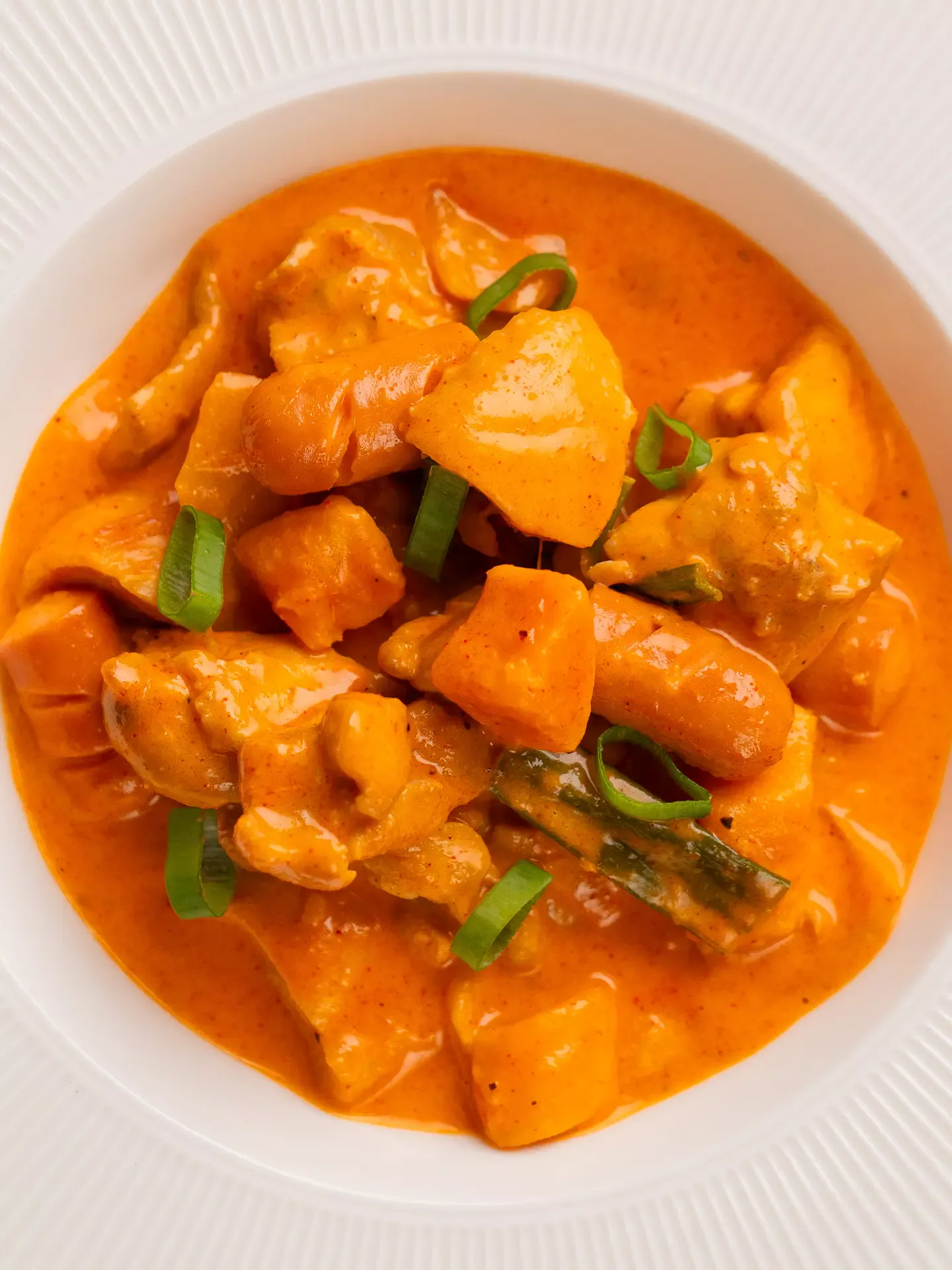
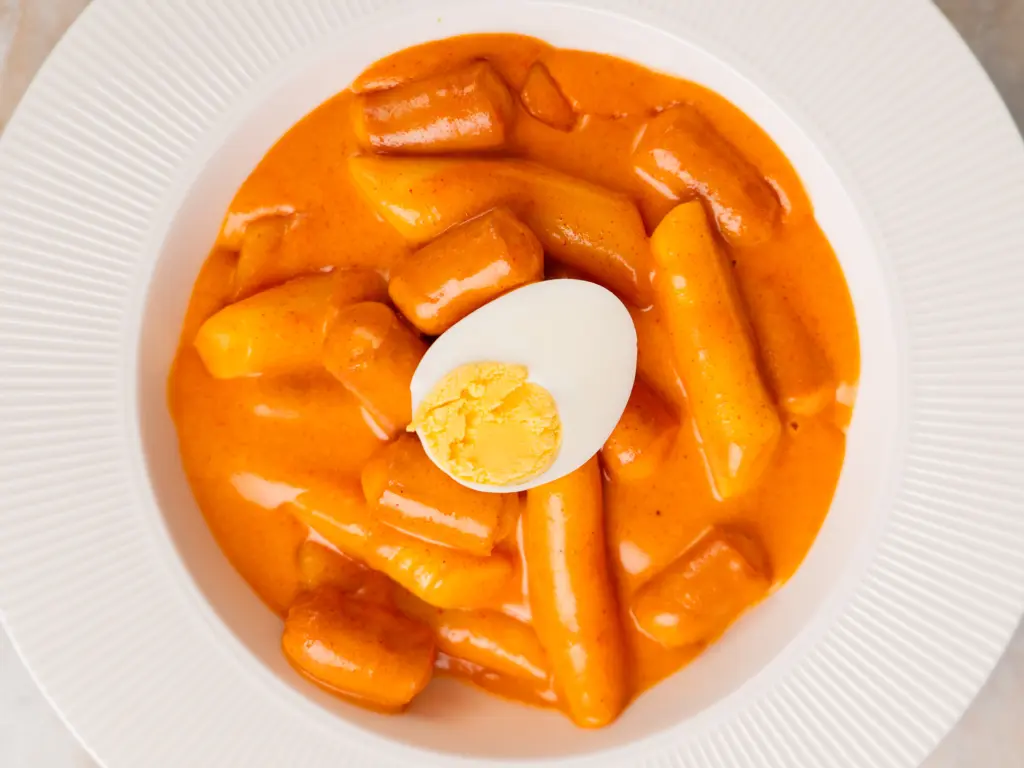
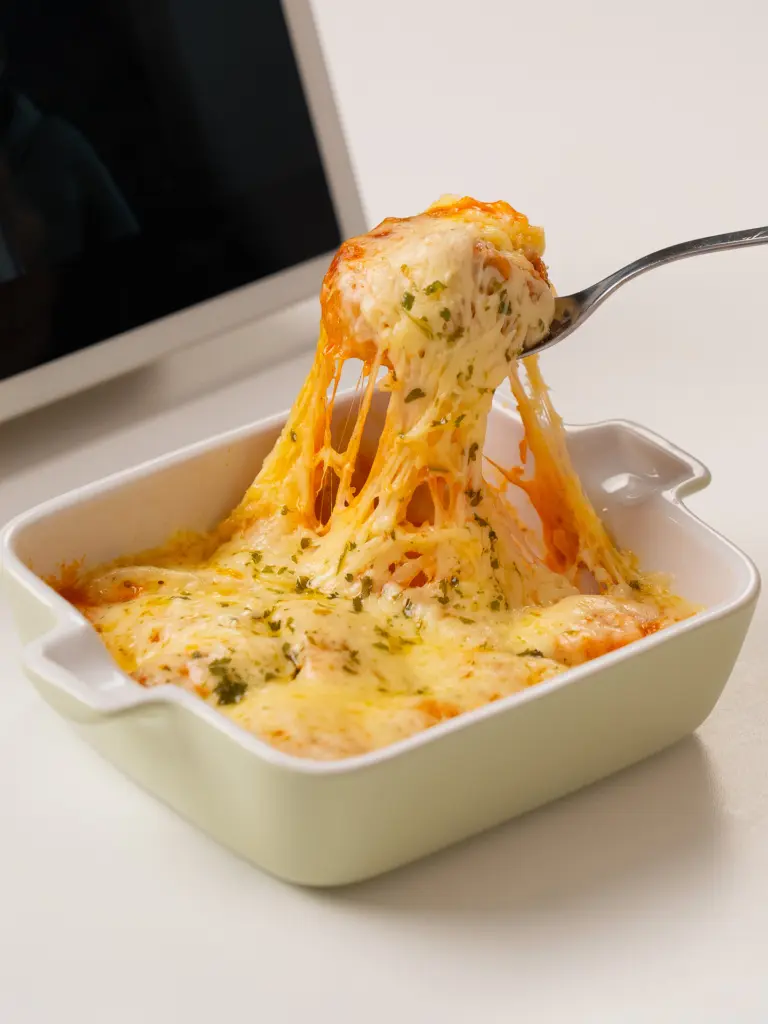
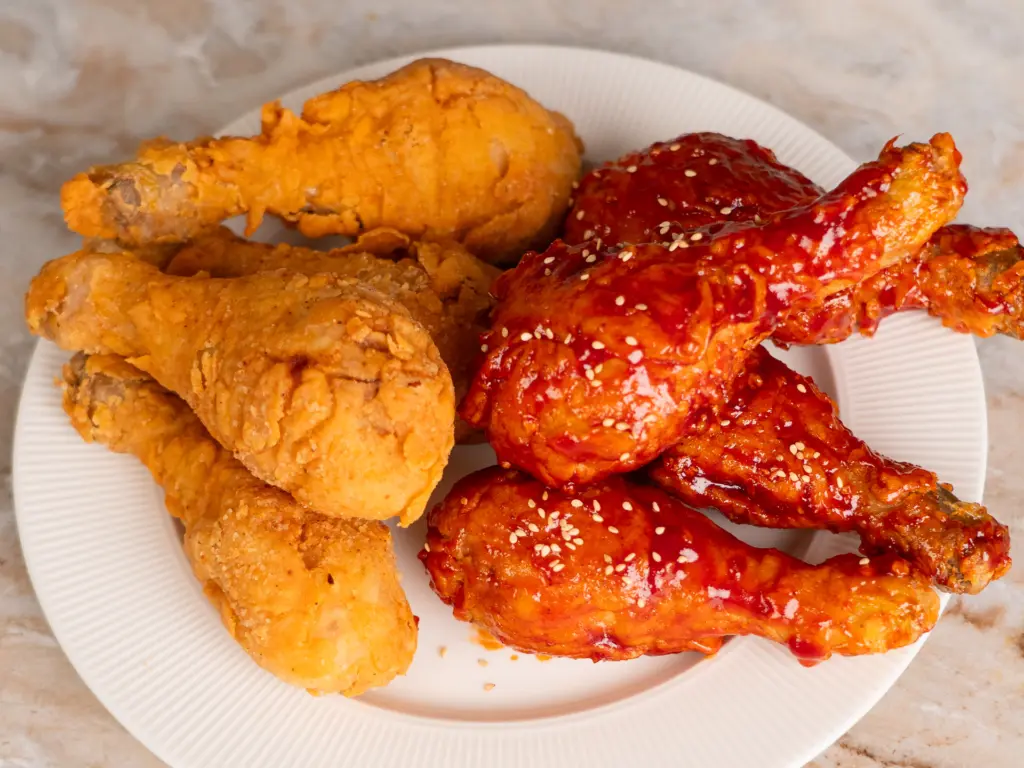
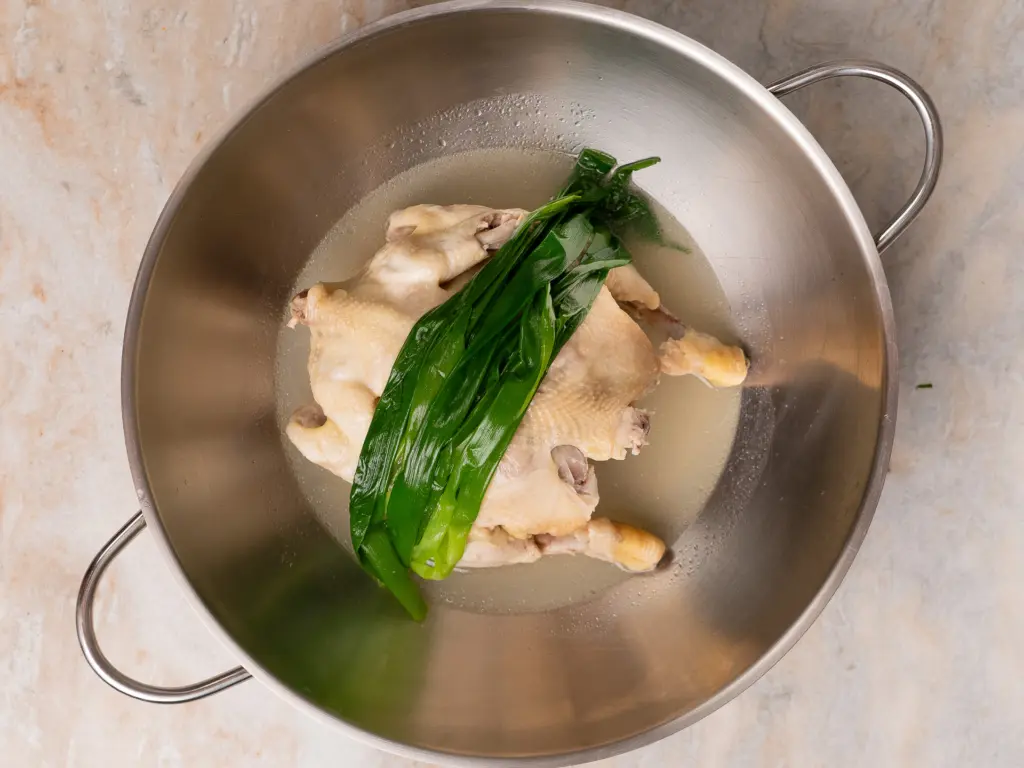
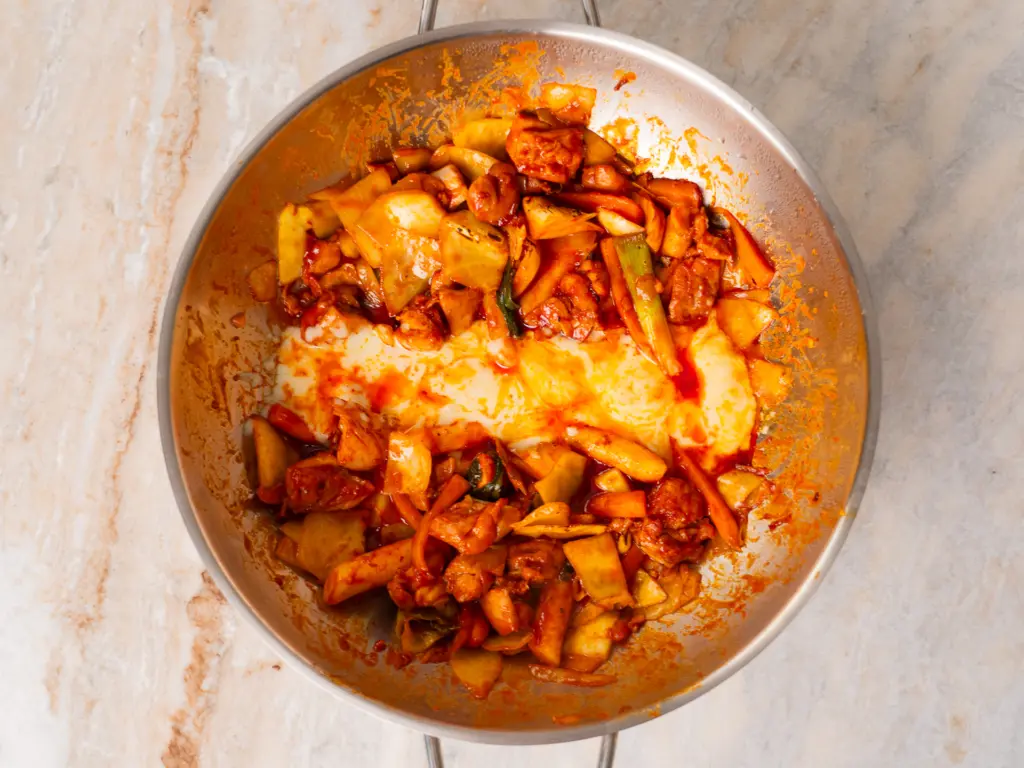



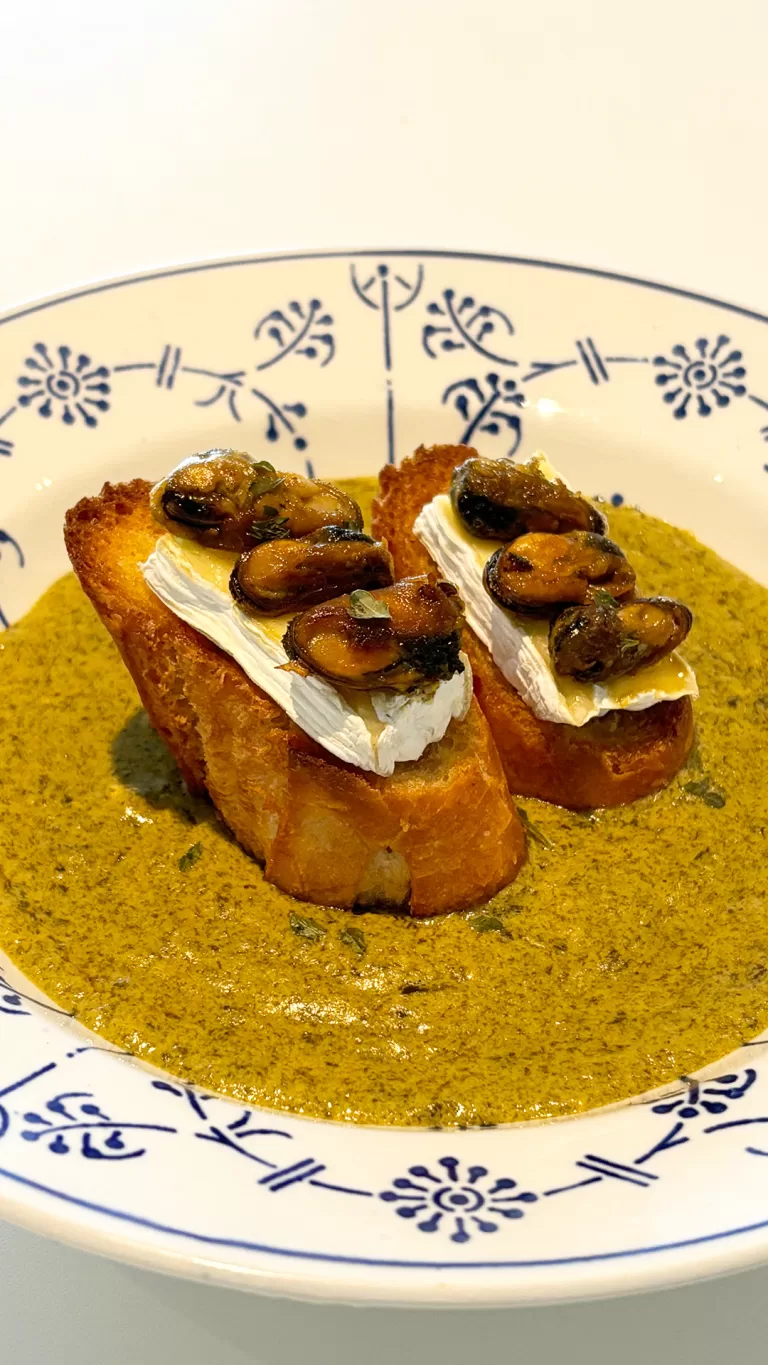
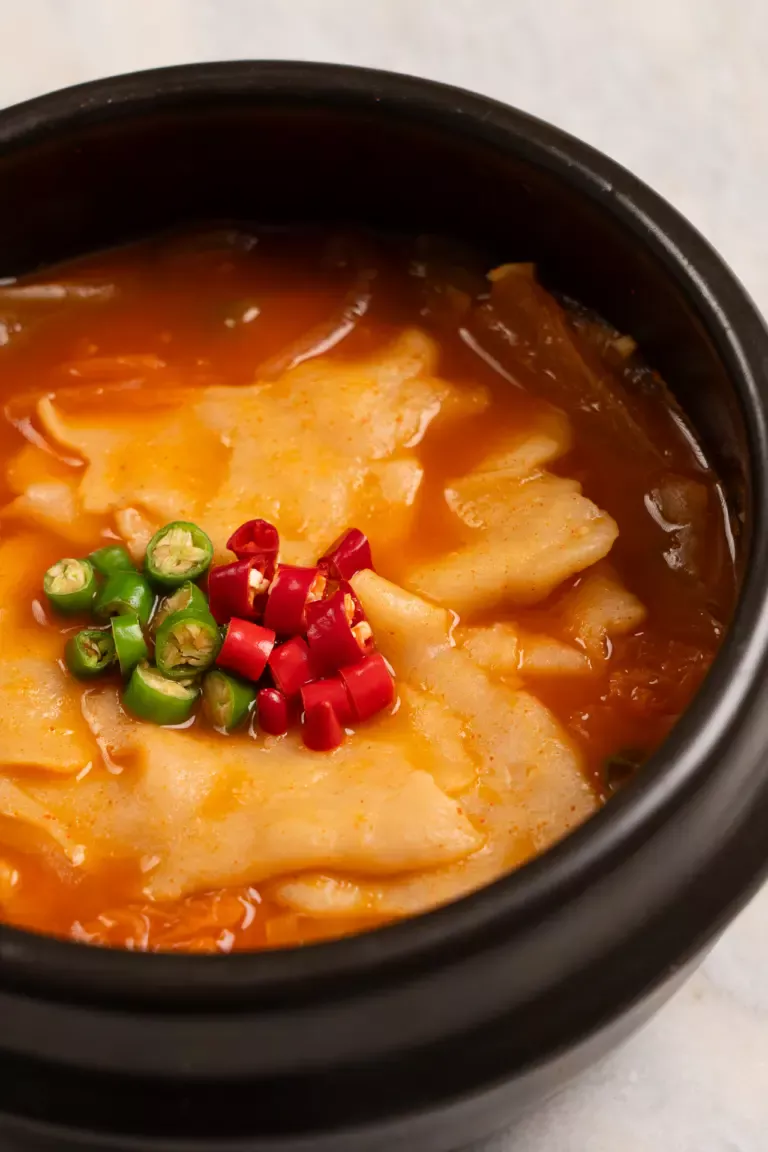
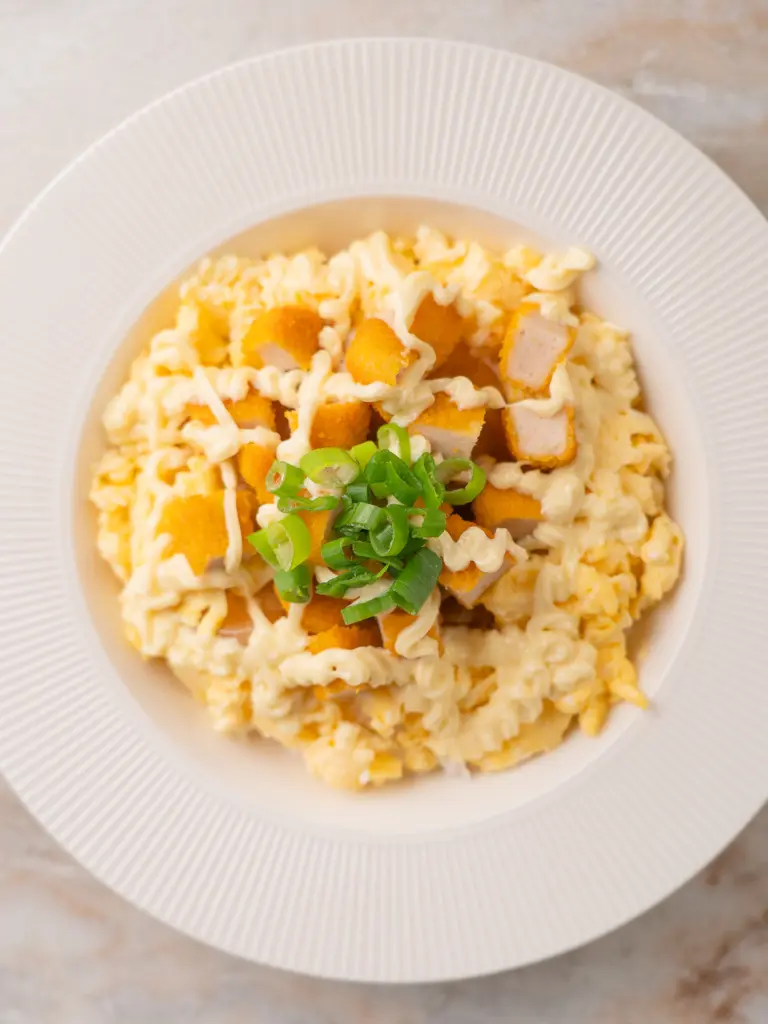
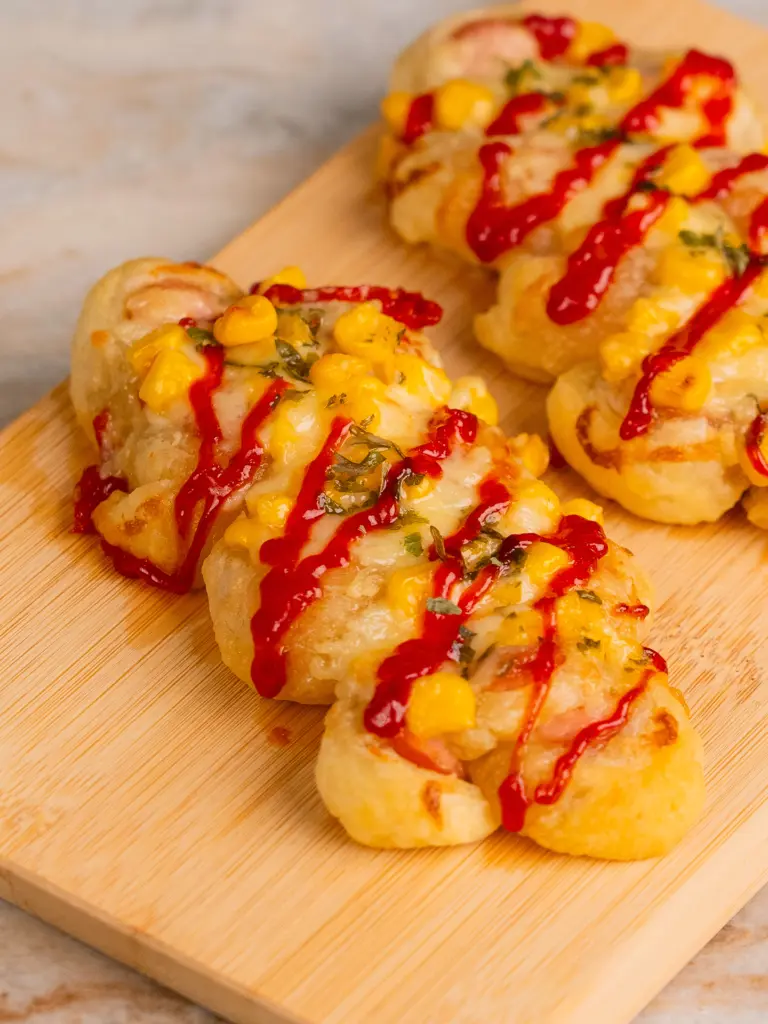
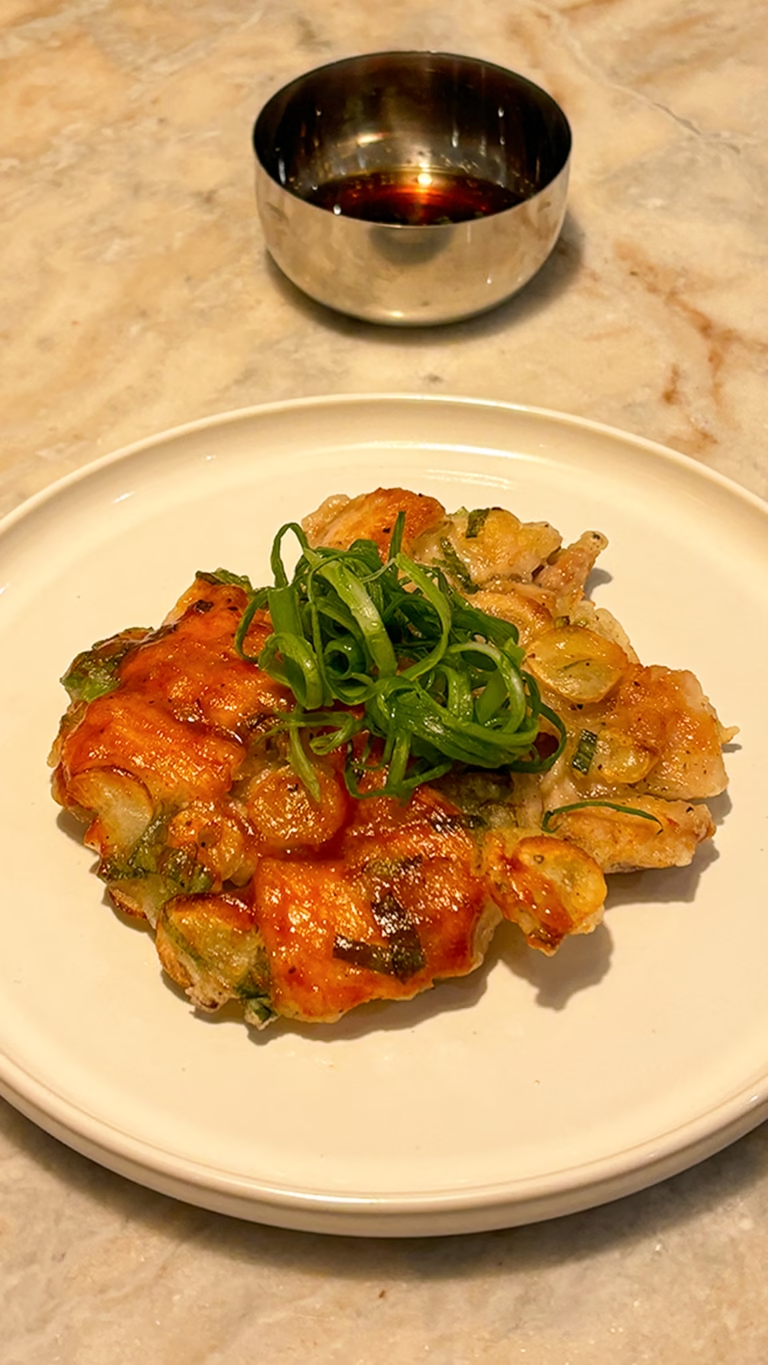
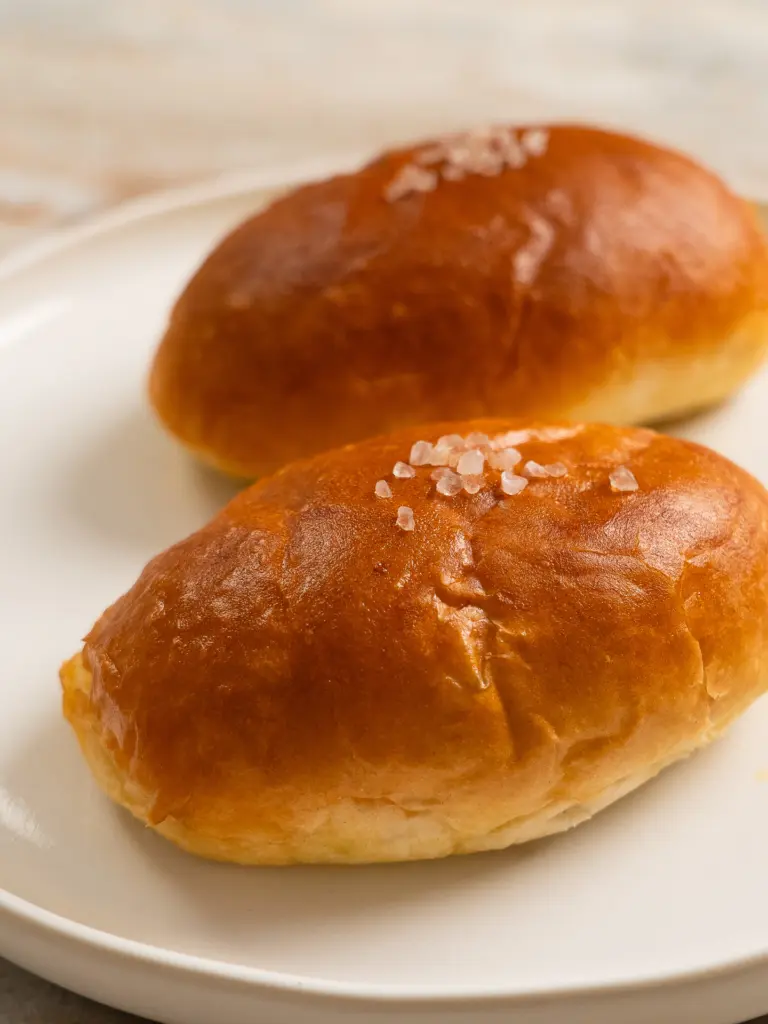
Super easy to make and taste amazing!!!